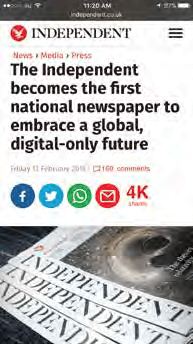Issue:

A former Tokyo stringer laments the demise of a great British newspaper and its Tokyo coverage.
by DAVID MCNEILL
In British parlance, the 9 p.m. watershed refers to the point where adult content can safely be screened on television. In our house it meant something different: the mercifully reduced risk of a call from an editor at the Independent, my sometime employer, asking for a late night file.
After years of these calls, the buzzing on my cell phone triggered a Pavlovian response: sweaty palms, raised heart beat, angry spouse. Occasionally, the voice on the other end wanted a story that Could Not Wait, but more often than not it was a request for a 600 word color piece, rewritten from the local wires.
And so it was that Independent readers came to know about chopstick bras, herbivorous men, yakuza wars, blowfish, Marxism manga books and countless other items on the London desk’s Far East shopping list. Then there was the dreaded double page spread, an off the cuff daily feature.
If all was working well, the spread was planned well in advance, but the Indy always flew by the seat of its pants. That meant being cajoled into pulling together 2000 words on some exotic topic (Japan’s pet boom; Clint Eastwood’s Iwo Jima movie) by midnight London time four or five hours away.
During a rare Tokyo visit the foreign editor told me of his ideal correspondent: the paper’s star reporter in America who could be yanked out of bed at 3 a.m. and induced to write 800 immaculate words on anything. “A total pro,” he said. Other writers were sent into war zones for weeks. Tokyo was a doddle, he laughed.
It was that kind of newspaper. The Indy paid buttons, often asked the impossible and rarely acknowledged either. Stringers were expendable. But its unique rough around the edges ethic only became clear when you visited its head quarters in London.
THE FOREIGN DESK WAS a single cluttered table. The people who made me want to metaphorically pull a blanket over my head in the evenings were harassed, overworked editors trying to run a world-class newspaper on a shoestring budget staffed by a handful of full time correspondents (and, even tually, not a single one in East Asia).
The paper had relocated from the London Docklands to Northcliffe House off the Kensington High Street in 2008 its fourth and final move in 22 years. The aim, of course, was to save money. It shared the building with the archconservative Daily Mail, Mail on Sunday, London Evening Standard, the Metro and London Lite hardly an easy fit for a freewheeling, center left title.
Launched in 1986 in the space opened up by the union busting of Rupert Murdoch (his assault on print workers had helped lower production costs, and prodded journalists from other quality titles, including his own, to jump ship), the Indy sold over 400,000 copies by the end of the decade (prompting Murdoch to slash the price of the Times.) There after, it slid and lurched from crisis to crisis, punctuated by remarkable highs.
Just after I took over as a stringer from Richard Lloyd Parry in 2002, it became the first broadsheet to switch to tabloid format, dubbed “compact” to distinguish it from the populist red tops. The front page was retooled, making it impossible to ignore: In 2004 it famously condemned the Hutton Report on the death of UK government scientist David Kelly with a one word headline “Whitewash?” It clawed back circulation and won British newspaper of the year in 2004.
That was typical of the Indy’s maverick, never say die spirit. In a crowded market segment dominated by the Times, Guardian, Daily Telegraph and the Financial Times, it was forced to consistently challenge the rules of what a newspaper could do. In design, it celebrated photography, anchoring its pages and foreign news to some of the most striking images in print history.
FROM THE START, INTELLIGENT writing was the paper’s hallmark and its pages became a platform for some of the greatest firstperson journalism of the last three decades. Robert Fisk, arguably the most celebrated correspondent of the era, helped put the foreign pages up in lights but the Indy was full of other famous reporting names, including Patrick Cockburn, Rupert Cornwell and (until he left) Lloyd Parry.
Though it resisted political pigeonholing, the paper was often on the right side of history, strongly arguing against the 2003 U.S.-led invasion of Iraq, for example, and lamenting Britain’s unqualified support for America’s “war on terror.” In 2007 it was rewarded by a bitter swipe from Prime Minister Tony Blair, who dismissed the Indy as a “viewspaper” not a “newspaper.”
It took a stand on the parliamentary lobby system, a sort of press club for British journalists widely criticized for spoon feeding them. “The Independent was not going to deceive its readers,” declared the paper’s then editor Chris Blackhurst. For years, he added, the paper banned its journalists from going on press trips. “Nothing was to be gained from going in a pack and being subjected to PR ‘spin’.”
But all these principled achievements and a string of innovative content refits (“let’s get Bono to edit!”) couldn’t halt the slide. In one of several final humiliations, the paper was traded between billionaires for a quid in 2010, sold by Irish mogul Tony O’Reilly to Alexander Lebedev, a Russian oligarch and ex-KGB spy. It was Lebedev’s son Evgeny who eventually broke the news to long suffering staff in February this year that with circulation at 40,000 and still sliding, the paper would print its last print edition the following month.
“It still amazes me . . . how the paper allowed me to wander. It was the greatest education of my life.”

The Indy’s helter skelter, 30 year ride triggered many affectionate eulogies. My former editor, Archie Bland, recalled “a lovely sort of chaos,” but said lack of resources “sometimes made getting the paper out each night seem like a Sisyphean miracle.” Journalists at the Independent were, he said, “quite apart from being fiercely talented, prepared to run through brick walls for each other.”
Because it was perpetually broke and forced to take risks, the Indy gave its staff “responsibilities, opportunities and scope which we’d never have had elsewhere,” wrote Lloyd Parry on Facebook. “It still amazes me . . . how the paper allowed me to wander,” he said, recalling weeks in Indonesia reporting its “horrors and wonders” during the late 90’s uprising. “It was the greatest education of my life.”
BY THE TIME I came along, such indulgences were rare. With notable exceptions, editors in the financially strapped 2000s were less willing to fund expensive reporting, though I loved how eccentric pitches (“I’d like to interview Imelda Marcos”) were rewarded with enthusiastic one line mails (“Go, man, go!”). And when the story was important, such as Japan’s 3/11 triple disaster, the paper was exceptionally generous with time, money and space.
Even in its demise, the Indy may like so many times be ahead of the curve, sadly so. It survives as a digital publication, employing a handful of editors to churn out copy, rewritten from articles it would once have commissioned. A recent piece from the Japan Times, reporting on blanket surveillance of Muslims living in Japan, was a case in point pilfered lock, stock and barrel.
That approach appears to be working at least for now. Online readership is up (helped by heavy promotion on Facebook and other social media). Around two thirds of the Independent’s UK readers access it only from mobile devices, according to Journalism.co.uk. But for better or worse, the Indy’s fate encapsulates the decline of old media and the rise of algorithmled churnalism.
Some digital optimists will be happy to see the citadels of mainstream journalism tottering, and it is possible that something better will arise from the rubble. But for now it’s hard to see what that is. As Cockburn, one of the Independent’s greatest talents recently wrote in another context: “We have entered “an age of disintegration.”
As for me, I won’t miss those late night calls. But I do sometimes long for the Indy’s beautiful bedlam.
David McNeill writes for the Irish Times, the Economist, and other publications.

